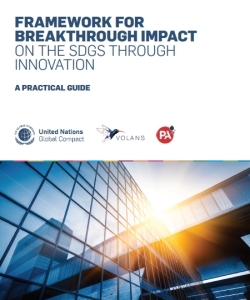
Using the Sustainable Development Goals to create breakthrough ideas
Tags
There’s a commonly held view that coming up with ideas is the easy part of innovation, but it’s not. It’s one of the hardest aspects of the process. There are many pitfalls, not least the temptation to fall back on old ideas or dismiss radical ones before they’ve been refined and explored. The fear of failure often means there can be a reluctance to experiment with a truly different approach.
Yet, with the right processes and tools, businesses can overcome those barriers and develop breakthrough ideas that will open up new market opportunities, help power their bottom line and have a positive impact in the world. Through our work with the UN Global Compact and Volans, we’ve set out an approach to generating breakthrough ideas and turning them into reality.
Our approach uses the United Nation’s Sustainable Development Goals (SDGs) – the 17 pledges to overcome humanity’s greatest challenges by 2030 – as a lens through which to identify problems and innovate in powerful new ways. Using this approach, you will not only generate new growth, but in doing so transform lives and contribute towards a greater goal.
Defining the problem
A well-defined problem is your catalyst to understand the ‘why’ and to stimulate ideas on how to tackle the problem. The SDGs are a great place to start as they represent the needs of the world and its people. Our guide includes an overview of our SDG Goal Finder, a tool to help teams develop clarity about the problems they wish to solve and the SDGs they’re addressing.
Once your problem and the people it affects is well-understood, stoke creativity by gathering inspiration before creating solutions. Think about what existing or emerging technology might do to solve the problem and find examples of these technologies in practice. Look at how others are approaching problems, especially leaders and disruptors. Finally, prepare to adopt the broadest perspective – if you’re feeling uncomfortable, you’re probably in the right mindset.
Only once this groundwork has been laid is it time to start generating ideas, whether through brainstorming, word association or other techniques. Now it’s about numbers, producing as many ideas as possible without any quick judgements. Once you’ve gathered the full range of ideas, you can move into the final step of evaluation: assessing their feasibility and prioritising and deciding which ones merit development. Any desired outcome should be ambitious but not abstract; not achieving zero hunger but improving agricultural productivity to feed more people.
It’s the approach we took when asking how to solve the problem of plastic usage in tea bags. We started with understanding the context, then the value of solving the problem, and what had already been done. We then moved on to the delivery, reviewing who was already working on the problem, what potential partners there were and obstacles to progress. This method enabled our experts to develop an idea that led to the creation of a working prototype of a new plastic free tea bag. This uses a sustainable compostable tea sheet made of lokta pulp to provide a practical business solution to an environmental problem.
Making ideas reality
There are three tools in our report that can help both with idea generation and making ideas a reality. The first of these is design thinking, which brings together analytical thinking and creativity to focus in on the needs and possibilities around a desired outcome to foster inspiration.
Lean start up is another technique that can prove helpful. It’s a scientific process used in new businesses to get products to market quicker. It starts by developing a hypothesis, then testing it through prototypes, learning from those tests and repeating the process at speed.
Another tool is Agile. This approach is especially suited to complex, broad problems because it breaks things down into short pieces of work using multi-disciplinary teams. This helps enable trial and error approaches, where lessons are learned quickly from experiments, enabling breakthroughs to come faster. When Water Source Australia, a B-Corp start-up, developed an innovative decentralised water treatment facility to empower water providers and users with potable water, we used an Agile approach to co-create the Internet of Things interface for analytics, treatment and maintenance of the water treatment unit, helping to commercialise the product in less than two years.
Generating ideas isn’t easy but the SDGs offer a lens through which businesses can generate new value. In doing so, leaders can simultaneously help us progress towards meeting the SDGs – improving lives across the world.

Framework for breakthrough impact on the SDGs through innovation
Explore more





